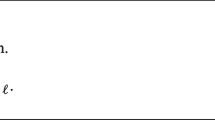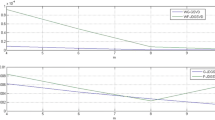Abstract
The singular value decomposition (SVD) of a data matrix is useful for providing rank and subspace information as well as solving and analyzing total least squares (TLS) problems. Rank-revealing decompositions, herein referred to as UTV decompositions, and Lanczos methods have been proposed as substitutes for the SVD in various applications through the years. These type of methods are appropriate for solving TLS-related problems because they can efficiently and reliably provide an orthogonal basis that accurately approximates the needed numerical row space or null space.
The development and availability of reliable and robust codes for TLS algorithms always lags the pace of the literature. We discuss some recent developments in the use of UTV decompositions and Lanczos methods for solving TLS-related problems along with related Matlab codes.
Access this chapter
Tax calculation will be finalised at checkout
Purchases are for personal use only
Preview
Unable to display preview. Download preview PDF.
Similar content being viewed by others
References
H. Barkhuijsen, R. D. Beer, and D. V. Ormondt. Improved Algorithm for Non-iterative Time-Domain Model Fitting to Exponentially Damped Magnetic Resonance Signals. J. Magn. Reson., 30: 553–557, 1987.
J. L. Barlow, P. A. Yoon, and H. Zha. An Algorithm and a Stability Theory for Downdating the ULV Decomposition. BIT, 36: 14–40, 1996.
A.W. Bojanczyk and J.M. Lebak. Downdating a ULLV Decomposition of Two Matrices, in J.G. Lewis (Ed.), Applied Linear Algebra, SIAM, Phil., 1994.
A.K. Cline, A.R. Conn, and C.F. Van Loan. Generalizing the LINPACK Condition Estimator. in J.P. Hennart (Ed.), Numerical Analysis, Lecture Notes in Mathematics, 909: 73–83, Springer, 1982.
J.W. Daniel, W.B. Gragg, L. Kaufman and G.W. Stewart. Reorthogonalization and Stable Algorithms for Updating the Gram-Schmidt QR Factorization, Math. Comp., 30: 772–795, 1976.
R. de Beer and D. van Ormondt. Analysis of NMR Data Using Time Domain Fitting Procedures. in NMR Basic Principles and Progress, Vol. 26, Springer-Verlag, Berlin, 1992.
L. Eldén and E. Sjöström. Fast Computation of the Principal Singular Vectors of Toeplitz Matrices Arising in Exponential Data Modelling of a Toeplitz Matrix. Signal Processing, 50: 151–164, 1996.
R.D. Fierro. Lanczos, Householder Transformations, and Implicit Deflation for Fast and Reliable Dominant Singular Subspace Computation. Num. Lin. Alg. with Applic., 8: 245–264, 2001.
The software is available from the authors’ home pages: R.D. Fierro: http://www.csusm.edu/Math/fierro/RDF.html. P.C. Hansen: http://www.imm.dtu.dk/—pch.
R.D. Fierro, P.C. Hansen, and P.S.K. Hansen. UTV Tools: Matlab Templates for Rank Revealing UTV Decompositions. Numer. Algo., 20:165–194, 1999.
R.D. Fierro, L. Vanhamme, and S. Van Huffel. Total Least Squares Algorithms Based on Rank-Revealing Complete Orthogonal Decompositions. in Recent Advances in Total Least Squares Techniques and Errors-in-Variables Modeling, S. Van Huffel, ed., SIAM Proceedings series, 1997, pp. 99–116.
G. Golub and C. V. Loan. Matrix Computations. John Hopkins University Press, 1996.
S.H. Jensen, P.C. Hansen, S.D. Hansen, and J.Aa. Sorensen. Reduction of Broad-band Noise in Speech by Truncated QSVD. IEEE Trans. Audio Speech Proc., 3: 439–448, 1995.
J. Kuczynski and H. Wozniakowski. Estimating the Largest Eigenvalue by the Power and Lanczos Algorithm with a Random Start. SIAM J. Matrix Anal. Appl., 13: 1094–1122, 1992.
S. Kung, K. Arun, and B. Rao. State-space and Singular Value Decomposition-based Approximation Methods for the Harmonic Retrieval Problem. J. Opt. Soc. Am., 73: 1799–1811, 1983.
F. T. Luk and D. Vandevoorde. Decomposing a Signal into a Sum of Exponentials in R.H. Chan, T.F. Chan, and G.H.Golub (Eds.) Iterative Methods in Scientific Computing, Springer, 1997.
M. Moonen, P. Van Dooren, and J. Vandewalle A Note on Efficient Numerically Stabilized Rank-One Eigenstructure Updating. IEEE Trans. on Signal Proc., 39: 1911–1913, 1991.
B. Ottersten and T. Kailath. Direction-of-Arrival- Estimation for Wide-Band Signals Using the ESPRIT Algorithm. IEEE Trans. on Acoustics, Speech, Signal Proc., 38: 317–327, 1990.
H. Park and L. Eldèn. Downdating the Rank Revealing URV Decomposition. SIAM J. Matrix Anal. Appl., 16: 138–155, 1995.
K.J. Ray Liu, D. O’Leary, G.W. Stewart, and Y.J. Wu. URV ESPRIT for Tracking Time-Varying Signals. IEEE Trans. on Signal Proc., 42: 3441–3448, 1994.
G.W. Stewart. An Updating Algorithm for Subspace Tracking. IEEE Trans. on Signal Proc., 40: 1535–1541, 1992.
G.W. Stewart. Updating a Rank-Revealing ULV Decomposition. SIAM J. Matrix Anal. Appl, 14: 494–499, 1993.
Data Set 002 from the BioSource Database can be accessd at http://www.esat.kuleuven.ac.be/sista/members/biomed/data002.htm.
S. Van Huffel, L. Aerts, J. Bervoets, J. Vandewalle, C. Decanniere, and P. Van Hecke. Improved Quantitative Time-Domain Analysis of NMR Data by Total Least Squares. in Proc. 6th Eur. Sign. Process. Conf. (EUSIPCO), vol. III, 1992, pp. 1721–1724.
S. Van Huffel, H. Chen, C. Decanniere, and P. V. Hecke. Algorithm for Time-domain NMR Data Fitting Based on Total Least Squares. J. Magn. Reson., 110: 228–237, 1994.
L. Vanhamme, R. Fierro, S. Van Huffel, and R. D. Beer. Fast Removal of Residual Water in Proton Spectra. J. Magn. Reson., 132: 197–203, 1998.
Author information
Authors and Affiliations
Editor information
Editors and Affiliations
Rights and permissions
Copyright information
© 2002 Springer Science+Business Media Dordrecht
About this chapter
Cite this chapter
Fierro, R.D., Hansen, P.C. (2002). Recent Developments in Rank Revealing and Lanczos Methods for TLS-Related Problems. In: Van Huffel, S., Lemmerling, P. (eds) Total Least Squares and Errors-in-Variables Modeling. Springer, Dordrecht. https://doi.org/10.1007/978-94-017-3552-0_5
Download citation
DOI: https://doi.org/10.1007/978-94-017-3552-0_5
Publisher Name: Springer, Dordrecht
Print ISBN: 978-90-481-5957-4
Online ISBN: 978-94-017-3552-0
eBook Packages: Springer Book Archive




